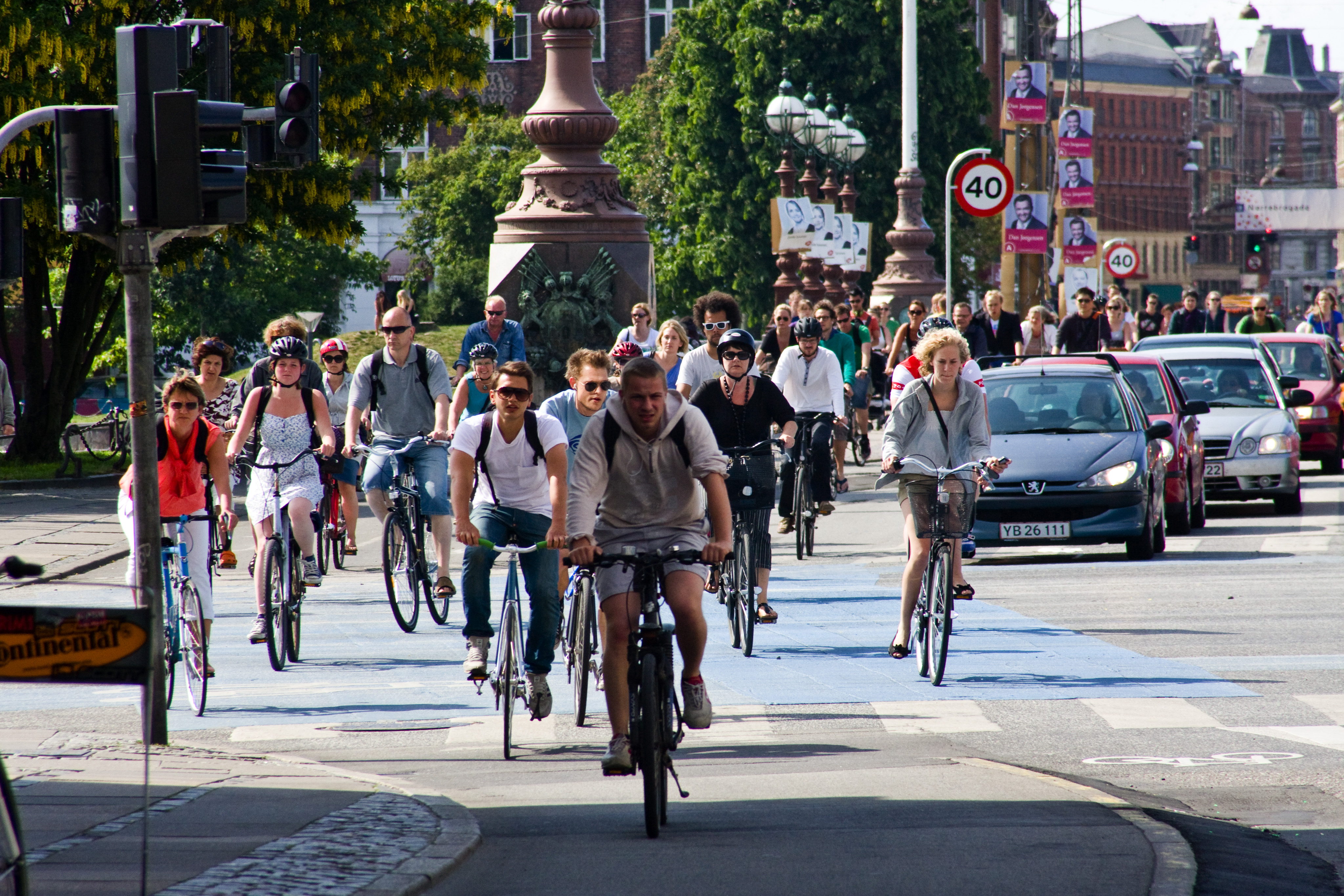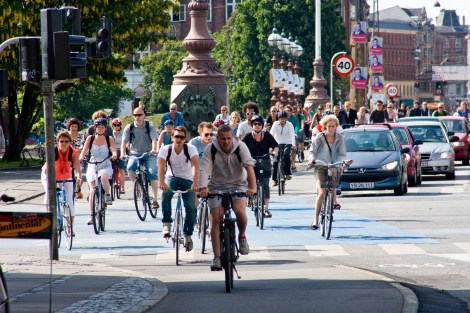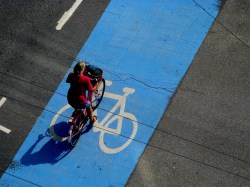This is part 2 of a short series about bicycles in Copenhagen. Read parts 1 and 3.
As an American on my first visit to Copenhagen a few weeks back, I was whopperjawed by the bicycle traffic on the “bike tracks” that swallow up a lane on each side of many city streets there.
Particularly mind-blowing was the cavalcade of bicyclists that charged across a certain bridge just a few hundred feet from my hotel — a bridge that, I later learned from city officials, probably sees more bike traffic than any other in the world. Queen Louise’s Bridge (Dronning Louises Bro to the Danes) carries over 40,000 bicycles each day. For perspective, that’s more than twice as many people as bike to school or work each day in the entire city of Portland, Ore., which is roughly the same size as Copenhagen.
Standing on Queen Louise’s Bridge at rush hour, you watch the crush of bike-riding humanity riding past. The riders queue up at the stoplights at either end of the bridge, and woe be to the pedestrian (or driver, for that matter) who gets in their way when that thing turns green. It’s such a spectacle that, since the city widened the bike tracks and sidewalks about five years ago, the bridge has become a popular hangout and people-watching spot for young Copenhageners. Some have taken to calling it the “hipster bridge.”
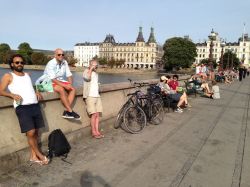
Greg HanscomA summer evening on the “hipster bridge,” which carries 40,000 bikes each day.
More than a third of the residents of the Copenhagen metro area — 36 percent, by the city’s count — bike to school or work each day. That blows away any city in the U.S.: In Portland, top among U.S. cities, only 6 percent of commuters go by bike. And a whopping 75 percent of Copenhagen cyclists ride year-round, despite the fact that the weather in this city, which is at roughly the same latitude as Juneau, Alaska, was described by almost every local I spoke to as flat-out “shitty” (imagine Seattle, only darker in winter).
Copenhageners are proud of their biking habits. “It’s like brushing your teeth — it’s something everyone does,” says Marie Brøndom Bay, a representative of the city’s bicycling division. But those numbers have been hard-won. And to Brøndom Bay and other city officials charged with minimizing car traffic and air pollution, and promoting public health, even a third of the populace on bikes is not nearly enough.
As in most European cities, cycling was bigger in Copenhagen 100 years ago. The Danish capital hosted the first world road racing championship in 1921. And bikes flourished here during the first and second world wars. But like in other cities on the continent, car culture revved up in the 1960s and swept aside bike usage. By 1970, only about 10 percent of road users were bicyclists. Bikes saw something of a resurgence during oil shortages in the 1970s, when Copenhagen instigated car-free Sundays (Hello Ciclovía!), and riding rose through the 1980, ’90s, and early aughts. But the numbers of bikers never returned to anything close to pre-1960s levels.
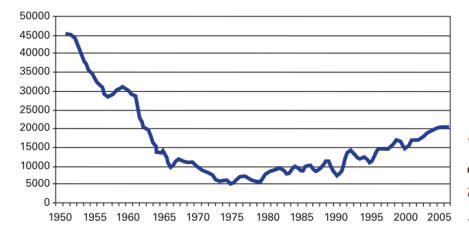
FietsberaadThe number of cyclists riding into Copenhagen during morning peak rush hour, 1950-2005.
In recent years, city officials have fought hard just to hold ridership levels steady, and of late, they’ve had a hard time convincing more residents to ride. One local transportation policy wonk wonders if Copenhagen has hit a “glass ceiling” with cycling. It’s a problem: The city council has pledged to make the city CO2 neutral by 2025, and that will require more people to bike.
City planners have set out to get fully half of the citizenry to cycle by 2015 — a goal that will require an additional 55,000 people to ride rather than drive. (Encouraging cycling is also a part of official Danish health policy: The city estimates that biking already saves about $300 million annually in health costs.) But numbers have been slow to tick up, despite some remarkably innovative programs designed to boost bicycling — programs that one transportation official describes as “the carrot, the whip, and the tambourine.”
When officials talk about the carrot, they mainly mean better bike infrastructure. The most obvious part of this is the ubiquitous cycle tracks. Unlike most of the bike lanes in the states, Copenhagen’s bike tracks are separated from car traffic by at least a curb, and in many places by a row of parked cars. The city boasts more than 225 miles of cycle tracks, and in recent years has spent considerable resources maintaining and upgrading them. In my experience, cycle tracks were often in better shape than the streets.
To encourage more people on the outskirts of the city proper to ride, Copenhagen began construction on a web of “cycle superhighways” connecting outlying areas to the city center. The first one was completed last summer, and connects the city with the suburb of Albertslund. I took a dreamy ride on it one afternoon: Lined with greenery and wide enough for four cyclists riding abreast, it wound through a local university campus and over bike-only bridges spanning busy roads. Where it paralleled roads with cars, it was separated from the traffic by both a curb and a line of parking spaces. Biking here was stress-free — quite a contrast to my route to work in Seattle, which one international bike expert recently called “death-defying.”
Other carrots include what transportation planners call the “green wave” — traffic lights timed to match the speed of cyclists and thus minimizing waits at red lights. The city also offers tax incentives for residents who commute by bike, and for employers who provide services such as bike parking and showers. There are phone apps for route-finding and reporting trouble spots. And it’s easy to mix and match biking with other modes of transport: You can bring your bike on the train at no charge, and taxis are required to have bike racks.
The biggest whip that drives people away from cars and onto bikes is probably the sky-high cost of gasoline — a gallon of gas cost about $8.50 when I visited in July. Of course, the 180-percent tax that the Danish government levies on car purchases hurts plenty, too. (Denmark has pledged to wean itself from fossil fuels completely by 2050.)
But the city has its own whips, first among them being the steady whittling away of car parking in the city center, combined with an increase in the cost of remaining parking spots. Narrowing or eliminating car lanes to make room for more bike tracks — a trend that seems to make Brøndom Bay especially proud — adds further disincentive for drivers. So does turning streets into bike parking lots outside of train stations.
And the tambourines? On Queen Louise’s Bridge, the city has installed a bike counter that ticks off the number of cyclists that have passed each day, giving riders a sense that they’re part of a movement, not just lost in the crowd. At many intersections, the city has installed footrests for cyclists waiting at red lights emblazoned with friendly messages like, “Hi, cyclist! Rest your foot here … and thank you for cycling in the city.” But the most innovative of all is the “bike butler” program: brightly clad city workers who tidy up the bike parking areas, and will even do minor repairs while the owners of said bikes are away.
It’s a remarkable collection of policies and incentives — but it’s unlikely to be enough to get 50 percent of residents cycle commuting by 2015. Officials are already downplaying those numbers, in fact. The goal, you see, was predicated on another big whip: The government planned to put a “congestion ring” around the city center, like London’s, and charge drivers to bring cars into the city. But that was scrapped last year in the face of opposition from suburban mayors and residents who learned that they would likely not get the major reductions in train and bus fares into the city that they’d been promised.
Still, city officials hold to the official goal, even if it looks increasingly unrealistic. Ultimately, Brøndom Bay explains, the challenge is one of building a bike culture that gets people to change their habits without sacrificing their current lifestyle. For the über-stylish Danes, that might require a reordering of morning priorities: “You need good, close bike infrastructure — and you also need to bring your mascara to work.”
Next: How U.S. cities are becoming “Copenhagenized.”

